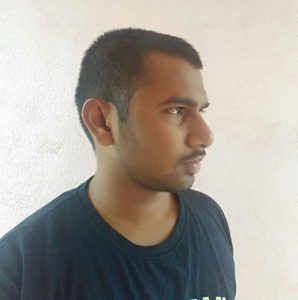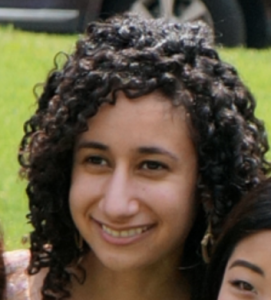About the authors:
 Abhinav Bakshi (performer, writer) is a computer engineer, web developer, and graphic designer. He developed his first software at the age of 18. He spends most of his time breaking and making stuff. When he is not working on his computer, he likes to go on adventure trips and socialize with people. Abhinav Bakshi (performer, writer) is a computer engineer, web developer, and graphic designer. He developed his first software at the age of 18. He spends most of his time breaking and making stuff. When he is not working on his computer, he likes to go on adventure trips and socialize with people. |
 Akshay Mande (performer) has been in theatre since 2011 as an actor and dancer. He has been working in a Pune-based experimental theatre group, Dhyaas Performing Arts, over the last two years. He was a part of two award-winning verbal plays called “Parvana” and “Andharach Bet” which claimed the first prize at Maharashtra Government’s Rajyanatya Spardha at Pune centre. He was also a part of a physical theatre based play called “The Transparent Trap” which was performed at one international and four national theatre festival’s including National School of Drama’s Bharangam 2016. Akshay Mande (performer) has been in theatre since 2011 as an actor and dancer. He has been working in a Pune-based experimental theatre group, Dhyaas Performing Arts, over the last two years. He was a part of two award-winning verbal plays called “Parvana” and “Andharach Bet” which claimed the first prize at Maharashtra Government’s Rajyanatya Spardha at Pune centre. He was also a part of a physical theatre based play called “The Transparent Trap” which was performed at one international and four national theatre festival’s including National School of Drama’s Bharangam 2016. |
 Amol Karale (writer) works in IT. He lives spontaneously and believes life is like a river with no beginning or ending. He stammers and is a member of the Indian Stammering Association. He loves reading books and doing yoga and meditation. Amol Karale (writer) works in IT. He lives spontaneously and believes life is like a river with no beginning or ending. He stammers and is a member of the Indian Stammering Association. He loves reading books and doing yoga and meditation. |
 An.. An. Ans..Anshu Vij (writer) is 24 years of age from Bhilai, Chhattisgarh. He works as an engineer at Tata Elxsi Pune. A proud stammerer from birth, Anshu loves to watch inspirational movies, reading books and is a music freak. To know more about him, see the theatre show, “I Was Quiet, But I Was Not Blind”. An.. An. Ans..Anshu Vij (writer) is 24 years of age from Bhilai, Chhattisgarh. He works as an engineer at Tata Elxsi Pune. A proud stammerer from birth, Anshu loves to watch inspirational movies, reading books and is a music freak. To know more about him, see the theatre show, “I Was Quiet, But I Was Not Blind”. |
 Anuprita Patil (performer, writer) has just completed her degree in commerce from Symbiosis College Of Arts and Commerce. She will be pursuing a graduate degree in law. Apart from academics she is passionate about dancing. She has learned a lot of dance forms and was a finalist of India’s Got Talent. She loves to sketch and play violin. Anuprita Patil (performer, writer) has just completed her degree in commerce from Symbiosis College Of Arts and Commerce. She will be pursuing a graduate degree in law. Apart from academics she is passionate about dancing. She has learned a lot of dance forms and was a finalist of India’s Got Talent. She loves to sketch and play violin. |
 Dhruv Gupta (performer, writer) is a Corporate Finance graduate with a minor in Informatics. His organizational experience spans environmental sustainability at cBalance Solutions, hospitality, digital marketing, software (mobile/web) design & development, and social-sector startups. He has co-founded businesses in China and a non-profit organization in India, Speak: Stammering Foundation. He is a Toastmaster and a member of the Indian Stammering Association. Dhruv Gupta (performer, writer) is a Corporate Finance graduate with a minor in Informatics. His organizational experience spans environmental sustainability at cBalance Solutions, hospitality, digital marketing, software (mobile/web) design & development, and social-sector startups. He has co-founded businesses in China and a non-profit organization in India, Speak: Stammering Foundation. He is a Toastmaster and a member of the Indian Stammering Association. |
 Nishu Bansal (writer) is a software engineer by profession and currently living in Pune. He enjoys music, nature, and reading inspirational books. He is a proud member of the Indian Stammering Association. Nishu Bansal (writer) is a software engineer by profession and currently living in Pune. He enjoys music, nature, and reading inspirational books. He is a proud member of the Indian Stammering Association. |
 Noura Embabi (workshop facilitator) is a Speech-Language Pathologist at the American Institute for Stuttering in New York City. She is an avid supporter of the self-help movement for people who stammer in the United States and India. For the past three years, Noura has worked under the mentorship of playwright and actor Heather Raffo in the Places of Pilgrimage series. Noura facilitated the Places of Pilgrimage workshop in Pune in order to increase the visibility of stammerers to their communities and to the rest of the world. Noura Embabi (workshop facilitator) is a Speech-Language Pathologist at the American Institute for Stuttering in New York City. She is an avid supporter of the self-help movement for people who stammer in the United States and India. For the past three years, Noura has worked under the mentorship of playwright and actor Heather Raffo in the Places of Pilgrimage series. Noura facilitated the Places of Pilgrimage workshop in Pune in order to increase the visibility of stammerers to their communities and to the rest of the world. |
 Saggherr Loadhii (Director) obtained a Master’s degree in theatre from Lalit Kala Kendra, University of Pune. He has extensive experience in children’s theatre for over 12 years. He has won multiple National and State Level Awards for Drama, Dance and Script Writing. He was selected to attend the workshop of Writer’s Bloc 4 and was awarded the “VINOD DOSHI FELLOWSHIP” for the year 2014-2015. He has not only authored, but also directed a number of plays for children. He has also facilitated innumerable theatre workshops for children through his theatre institute. Saggherr Loadhii (Director) obtained a Master’s degree in theatre from Lalit Kala Kendra, University of Pune. He has extensive experience in children’s theatre for over 12 years. He has won multiple National and State Level Awards for Drama, Dance and Script Writing. He was selected to attend the workshop of Writer’s Bloc 4 and was awarded the “VINOD DOSHI FELLOWSHIP” for the year 2014-2015. He has not only authored, but also directed a number of plays for children. He has also facilitated innumerable theatre workshops for children through his theatre institute. |
 Swapnil Shirsat (performer) is a professional actor. He is 25 years old and is compassionate about his career. Being a fun-loving and friendly person, Swapnil enjoys meeting new people. He likes to learn new things and believes that life is a beautiful journey that we should try to make more beautiful. Swapnil Shirsat (performer) is a professional actor. He is 25 years old and is compassionate about his career. Being a fun-loving and friendly person, Swapnil enjoys meeting new people. He likes to learn new things and believes that life is a beautiful journey that we should try to make more beautiful. |
 Vipul Patil (performer, writer) is currently pursuing a Master of Technology in Power Systems. He loves to run marathons, play volleyball, and he is also an avid trekker. He enjoys writing poetry and prose about his experiences. He regularly attends the Indian Stammering Association’s self-help group meetings. He is explorative and loves to experiment with new things. Vipul Patil (performer, writer) is currently pursuing a Master of Technology in Power Systems. He loves to run marathons, play volleyball, and he is also an avid trekker. He enjoys writing poetry and prose about his experiences. He regularly attends the Indian Stammering Association’s self-help group meetings. He is explorative and loves to experiment with new things. |
 Vivekanand Khatgaonkar (performer) is a theatre artist. He has performed as an actor in 7 full length plays, both Hindi and Marathi. Some of these plays include: Short Stories of Anton Chekhov, Court Martial, Muavje, Jis lahore nahi dekhya vo jamyai nai, and Holi. Vivek has also performed for social causes through street plays. Vivekanand Khatgaonkar (performer) is a theatre artist. He has performed as an actor in 7 full length plays, both Hindi and Marathi. Some of these plays include: Short Stories of Anton Chekhov, Court Martial, Muavje, Jis lahore nahi dekhya vo jamyai nai, and Holi. Vivek has also performed for social causes through street plays. |
 Lalit Singh is a quality analyst by profession, so he can relate to the positives and negatives in life just as easily and rationally. He believes in learning from life. Lalit enjoys playing pool, cycling, and cooking his own meals. Lalit Singh is a quality analyst by profession, so he can relate to the positives and negatives in life just as easily and rationally. He believes in learning from life. Lalit enjoys playing pool, cycling, and cooking his own meals. |
What if 99% of the world stammered?
No share or id values provided for youtube shortcode.Hakla Hakla (Stammerer Stammerer)
No share or id values provided for youtube shortcode.In May 2016, a group of eight stammerers met at a classroom in Vikhe Patil Memorial School in Pune, India, to begin a writing process that would culminate in a play written and performed by stammerers. This three-week theatre writing workshop was produced by Speak, a collective dedicated to fostering conversations that bring awareness and acceptance to human diversities. Titled “Places of Pilgrimage”, the workshop was originally designed by American playwright and actor Heather Raffo. Over the last decade, Raffo has led this workshop with university students and artists in the United States and internationally. After working under Raffo’s mentorship as a writer, Speech-Language Pathologist (SLP) Noura Embabi sought Raffo’s support to implement this workshop within the stuttering community in India. Noura then traveled to Pune to carry out this workshop, in collaboration with the Indian Stammering Association.
In a nutshell, “Places of Pilgrimage” aims to elicit first person stories from people who are underrepresented and/or misrepresented in mainstream media and society. Over the course of ten sessions (taking place after work hours and on weekends), participants explored ways of expressing their personal narratives to an audience. Workshop sessions consisted of two main components: intensive writing and theatrical exercises. The major themes discussed included the following:
- Journey: those that have changed you, inspired you, enlightened you; your biggest journey; your journey towards belonging; what your heart longs for when you set out on a journey
- Belonging/Identity: those who understand you best; the communities with which you identify; the ways in which you change for the worlds you serve
- Belonging/Place: spaces in which you belong; the person you are in public versus in private; where you feel most at home
- Dreams: those that feel possible to attain, those that feel out of reach, and those that feel impossible to achieve
- Shape/Structure: the significant events in your life, those that have shaped you, your moments of awakening, your operating metaphor
Exploring these themes often causes workshop participants to experience a “self-excavation” of sorts – deep reflection into themselves, their worlds, and the ways they have interacted with these worlds. Participants responded to the material in deeply creative and incredibly profound ways. The product was a combination of monologue, dialogue, poetry, and fiction. It was titled by the writers as “People Who Buffer: Theatrical Stories by Stammers”. Below are excerpts from each of the eight participants’ writing:
I am and I was always a dreamer. I believe in dreams because I’ve heard that they do come true. I am a kind of girl who is not shy to perform in front of people. In fact when I was a kid I always dreamt to act and sing and dance. If I had only three months left to live I would dance, dance, and only dance.
When I have everything a non-stammerer has, why am I afraid? Why am I not doing the things I love? When I possess all the other things a non-stammerer has - the confidence, the passion, the ability to dream and the strength to perceive the dream…
I am a stammerer and I am not disabled, for stammering is just another style or way of speaking. I am who I am and people will have to accept it, but only if I accept myself first.
Anuprita Patil
Chaos Chaos here you come.
Like a Tsunami you arrive,
Destroying everything in your path.
I faced you a lot of times.
I feared, I trembled to stand the force,
But vowed never to lose out.
Learned to come out bright as sunshine.
I have learned to smile as you come.
Like a swimmer you made me become.
Chaos chaos, please do come.
I invite you with a huge welcome.
Vipul Patil
He tells me every day is a struggle for him. He says he wants to end it all. He tells me he even tried committing suicide by cutting his hands with a knife, but he could not gather enough courage to do that. All he could do was cry at his helplessness and curse his fate for turning out this way. I feel sorry for this kid. Every time he meets me, he tells me, I should have been there to help him, support him and give him strength.
I try to run away, but no matter how fast I run, I cannot run away from myself. I feel responsible for that kid. Things would have been so much easier for that poor kid if someone like me would have taught him basic social skills. Someone like me would have told him that it is okay to stammer. That you are not defective; you are special. That making new friends is not as difficult as you think it is. It is okay to feel threatened in a new environment. It is okay to feel scared. But, all it takes is a little gesture, to gain a new friend and a dedication to cultivate a relationship.
The human mind is a complicated piece of art. Once you sow the seeds of doubt in it, you cannot do anything to stop the plant from growing. If Lord Rama himself sent Mata Sita to a forest upon getting the seeds of doubt from a Dhobi (washer man) in his kingdom, I am just a mortal. I cannot help but doubt if the kid from my past is the one holding me back.
Have you ever found that in your gravest moments, you have a moment of realization? Like a lightning bolt, with a blink of an eye, things become suddenly clear to you.
No, I am not sorry for what happened to him. I am not sorry he suffered. I am not sorry he got bullied by his peers. I am not sorry for whatever happened to that poor soul. I have carved my own path in my journey of life to reach where I am. If that kid thinks he can just climb on my back and make it without any pain or suffering, he’s got it all wrong. If he is getting bullied, he must stand up for himself. If he is lonely, he must learn to make friends. If he is having problems, he must fix them on his own.
I tell him that I am sorry for what happened to him and that I have come to terms with my past. I tell him I have forgiven my past and that he doesn’t have to come anymore, since I don’t need him.
Abhinav Bakshi
I used to make goals. But they were taking me nowhere. Nothing happened in my life according to plan. When I used to plan, something else would happen. Goals create a lot of confusion. I want to keep my future open. Living spontaneously helps a lot. I just concentrate on the things at hand and give my 100% to do it. It makes me happy.
I still stammer but I don’t bother. Now I focus on doing things that I want to do rather than on stammering. Thoughts will come and go. There is a quote that says, “Think before you leap,” but I think, first take a leap, and then think as much you want to think.
Amol Karale
I have seen my mum giving her gold ornaments as mortgage to pay my fees as well as my sisters’. My dad emptied his bank account in order to make us go to a good school and complete our education. I studied in a kind of okay college but I was not that focused on getting a good job because I knew that due to my stammering, I may not get any job - just as my relatives had said. But eventually I got a job. I was happy because now I would be able to help my parents and my siblings. From my childhood many people had said that I wouldn’t get any job. So I wanted to tell them, “See, I did it!” I wanted to tell my grade school teacher that stammering doesn't matter much if we are confident about ourselves. I wanted to tell her that if in the future someone like me comes to her class, she should not treat him like she treated me. But I realized that in a way she motivated me to work harder and prove her wrong. After getting the job I was so happy that I didn’t bother to tell her. In the end, I had to prove it to myself, not to her or to anyone else.
Anshu Vij
I am everything. I am nothing.
I am an environmentalist. I am a person who wreaks havoc on the environment.
I am me. I am not me.
I am 28. I am 5. I am 50. I am 100.
I am compassionate. I am not compassionate.
I am in a relationship. I am single.
I am the sun, the moon, the stars, the waves.
I am the insect, the butterfly, the lion, the sheep.
I am man, woman, child, teenager.
I am Indian, American, Chinese, Japanese, Philippino, Thai, British.
I am fluent.
I stammer.
I am…
All of these are mental constructs. Saying or thinking them does not make them true. So what is true? What is true is feeling. The feelings free from thoughts. Feeling light. Not reactive. Being in the here and the now. Love. Seeking love wherever I am. Opening myself up. Being vulnerable.
Dhruv Gupta
Oh my god, he thought it was cureless. But some person was shouting with confidence that he could cure it. He went running after him, confronted him. He started sobbing and said, “Why me?” The man said, “You are special. You have chosen this. See somebody gets migraines, someone gets cancer, someone gets blind. Likewise everyone has his/her quota. In the same way, you got this. It’s your choice. Way back in the past you made it. That’s the life you get.”
“Oh,” our hero said, “I see many people having illness but I don’t see people like me.” He smiled and said, “Because you are special, only 1 in 100.” The teen gathered some courage and asked, “What now? How to cure?” He said, “Acceptance is the key. As much as possible accept yourself, accept your voice the way it is, accept when someone laughs at it. This will help you come out stronger, confident, and a better speaker.” The teen didn’t expect this answer. He was looking for some device that could just fix him in minutes.
As he grew older in age, he began understanding acceptance. He fumbles, he rolls, gets up in his life, but still he has this ray of hope in his sulky eyes, walking upright to explore himself.
Lalit Singh
I think stammering is neither a disease nor a disability. I am making the assumption that a person can speak with ease and fluency to himself. If yes, then I think there is no problem at all. If stammering is a disease or biological defect, then one should not be able to speak to himself either. Let’s consider if a person doesn’t have legs, he is not able to walk in any situation. But that is not a case with stammering.
I don’t believe in labels, science, or anyone. I will only believe in myself. I am confident that one day I will become one of best speakers.
Nishu Bansal
In order to transform these written pieces into a play, participants worked with the Pune-based director Saggherr Loadhii of Aakanksha Balrangbhoomi Theatre. Saggherr worked with four of the writers and three professional actors – Akshay Mande, Vivek Khatgaonkar, Swapnil Shirsat – in order to theatricalize the eight narratives. Though the original plan was to hire professional actors to perform all of the written narratives, several participants strongly expressed that they wished to perform their own writing on stage. Fed up with living behind the scenes, they wanted to give voice to their own stories. As a result, the final production was a unique performance by stammerers and actors combined. Actors learned how to stammer by listening to the writers speak and discuss their stammering over the course of two weeks of daily rehearsals. Two runs of the play were then performed, with an audience of over 70 people attending across both days. Some writers chose to intentionally stammer during their performance, especially during “Hakla Hakla”, the song about stammering linked to this article. The play ended with the audience joining in song and in the process voluntarily stammering with the performers.
Audience members had the opportunity to engage in a post-show talk back with the writers, performers, and director. Additionally, a survey was collected before and after the play, in which audience members were asked to write their thoughts on stammering in an open-ended format. Below are a few direct quotes taken from surveys post-performance:
“We are all humans with varying fears, aspirations, dreams, etc. The more we open up, share, etc. and bring others into our world, the freer we all become.”
“Stammer! So what? I have my own style. I am different than the world. I can do everything because I am different. I can only enjoy life if I accept that I am different.”
“I come to know about other stammerers' perspective toward stammering. I learned a lot. It changed my perspective as well like I became more open minded towards stammering. All of my previous perspectives have changed a lot.”
“The play was an eye-opener to the society. We should learn the way to accept stammerers in our society and listen to them. More awareness is required.”
“After watching this play I realized that one of our friends is a stammerer and we should not make jokes on him. If we make jokes on him then that is fun for us but that is a very bad feeling for him.”
Feedback was collected anonymously from the workshop participants as well. All eight participants reported gaining confidence and self-expression over the course of the workshop. Most participants also reported gaining public speaking ability, empathy, creativity, and writing ability. When asked about seeing theatre as a tool for sharing the stories of stammerers, participants responded very positively. Several writers expressed that after participating in the workshop, they felt that theatre served as a powerful medium for learning more about self-expression and for conveying thoughts to a wider audience. Below are statements that participants wrote after completion of the workshop and performances:
“Whenever I will ever face a situation where I have to speak in public, nobody, including me, can stop me because I have done theater and most of them haven’t.”
“I mustn’t suppress my experiences. I must openly share them. Sharing with everyone is healing.”
“I never thought this was possible – to be on stage and organize such an event.”
“This experience gave me hope and added my confidence. This memory will act as a medicine when I will feel low in my future. I am sure after the play that one day, I will definitely become a great speaker.”
“By listening to others, I came to know there are many with me. I am not alone. Feeling of belonging.”
What’s next? In many ways, this play is only the beginning of a theatre movement by and for stammerers in India. Some exciting news:
- Another run of People Who Buffer will be performed on September 17, 2016 at the Varca Le Palms Beach resort in Goa, India. This will be part of the Indian Stammering Association’s national conference. All are welcome to attend this performance!
- Director Saggherr Loadhii is now conducting a children’s workshop with Aakanksha Balrangbhoomi Theatre to create a play in which stammering is the norm among the human population. Children who do not stutter will be performing in this play, and they are learning all about stuttering from adult members of the Indian Stammering Association.
- Speak will continue to hold theatre workshops for stammerers in various cities in India. If you are in Mumbai and would like to take part in a Places of Pilgrimage theatre writing workshop, contact Dhruv Gupta at dhruvg05@gmail.com for details regarding a second round happening in November 2016 for adults and February 2017 for children.
- This writing workshop will be held in New York City at the American Institute for Stuttering in 2017. If you would like to take part in it, please contact Noura Embabi at nembabi@stutteringtreatment.org and you will receive updates regarding workshop details as soon as they are available.
Media coverage on People Who Buffer:
Pune stammerers find their voice in theatre – The Indian Express – 15 June 2016
Getting their voices heard – Sakal Times – 24 June 2016
![]()

Wow! This is such a cool movement. Stuttering/stammering is extremely underrepresented and this is a great way of raising awareness. I connected with every single excerpt from the eight performers (especially the one about living life spontaneously rather than focusing solely on goals), and it’s great to hear that it made such an impact on your own self-exploration and confidence as well as audience members and readers. I loved the part when they were considering hiring professional performers, but the writers wanted to give their voices to the stories.
Thanks for sharing!
Hi Karissa,
Thank you for your comment. Yes, many of the writers wanted to perform and after some thought, it felt so obvious that they should! It was a daring act of self-expression and we hope that more people who stutter do this kind of artistic advocacy. I am glad you were able to connect with their writing!
Hi Karissa.
I am glad that you liked the article.I believe in living spontaneously. Their is no point in thinking about past and future.Both creates dilemma. This is the reason why i believe in present.I follow one quote in life “Either You live like a Buddha or a Buffalo”. Wherever mind is required i apply it otherwise i keep it aside.
Feel free to ask queries.
Thanks
G-G-great breakthrough!
Congrats Noura and Dhruv- and everyone!
Yes, stammerers must write their own script and voice it too.. if the message has to be authentic.
Humanity was never more ready to “new” ideas. Even eager.
Let us rethink not just stammering, but the whole question of Diversity and its role in human existence. The deeper purpose.
Best wishes to your creativity!
Hi Dr. Sachin!
Thank you for your point on the bigger picture. We’ve engaged the world of theatre and written expression as people who stammer – but really the possibilities are endless. Creating artistic pieces (whatever they may be!) for the “mainstream” is a process many underrepresented groups can undertake, and this redefines what is “normal” and what becomes a “common” diversity. The more that people who stammer share their stories, the more nuanced and varied the narratives can be, and the more visible we can be as a community.
What inspired you to adapt the screenplay for people who stutter and to bring the play to India?
This is such a wonderful project! I really enjoyed watching the videos and reading the excerpts. It sounds like that intensive writing and theatrical exercises were a powerfully cathartic experience for everyone involved. I hope that Speak and the Indian Stammering Association continue collaborating on wonderful projects like this! Thank you for sharing this work.
Yes, catharsis is a great word for this process! Thank you for your comment.
This article has by far been my favorite article to read thus far. I am blown away by the writing excerpts listed from the 8 participants, specifically by Anuprita Patil. I specifically do not stutter, but I am inspired at the viewpoint presented about the hardships that were faced and how they are welcomed now as an opportunity for success and not a situation of failure. Since the performance, have the 8 participants sought out more opportunities to share their experiences? Have they explored other avenues to tell their stories? Are there any other themes you are considering adding to the play to help others fully understand their experiences? Finally, what were the hired actors experiences of stuttering and how has their viewpoint changed of people who stutter?
Thank you for this amazing article, I loved it!
Mackenzie
Hello Mackenzie! i am glad that you liked the excerpts.Thank you so much.
Thank you for the reply! Have you explored any other avenues to tell your experience?
Thank you again,
Mackenzie Langston
Wow, this was such an amazing article! I’m a graduate student studying communication sciences and disorders, but I’ve always had an interest in theatre, so I was immediately drawn to this! The videos were wonderful, and the excerpts from the eight participants were so beautifully written. I really like that the writers themselves were able to act out their stories if they wished to do so, rather than have the professional hired actors play the role. I think that theatre is a great way to spread awareness, and the post-show discussion with the audience is such a wonderful idea! I also love the idea of the children’s workshop — that is just so cool! If only I lived closer so I’d be able to catch a production!
Thank you so much for sharing your work! It was absolutely wonderful!
Katie
Theater is a powerful medium. It opens a space for the audience to reflect and see themselves. In this case, the audience can say that they too are people who stutter, they are flawed, and they are human. As a theater artist I appreciate that the personal narrative is so much more compelling than language that tells me I should feel or think one way or another. As a future SLP I see this work as a wonderful way to empower the writer/performers, educate the public, and lift up a population that may not feel represented. Thank you all for daring!
Congratulations on this wonderful project, to have people who stammer work with actors, to get on stage and have the freedom to use their voices to get out the word about stammering!
congratulations!! You are a group of talented young people. I enjoyed your performances so much. God bless.
I’m truly impressed by both the project idea and the amazing ways of expressing what’s behind the stuttered speech. I know the German stuttering association works a lot with theater and song, but I wish we all did, as it’s such a great way to face and deal with stuttering. I hope to release a book with poems about stuttering one day. Thanks for being such an inspiration. So wish I could come to India, learn from you and bring your inspiration to Europe.
Keep talking,
Anita Blom